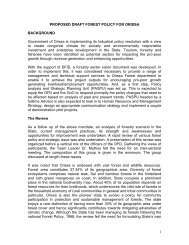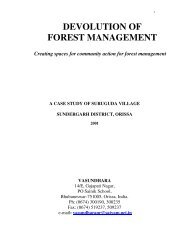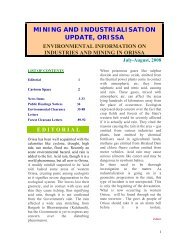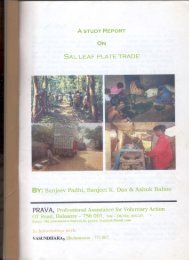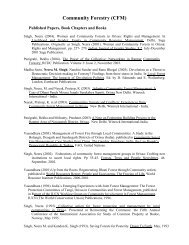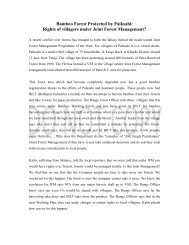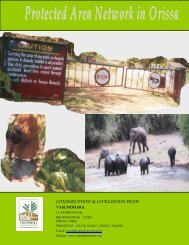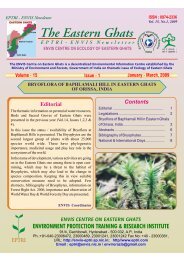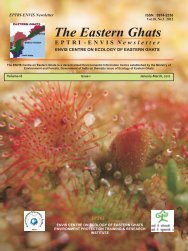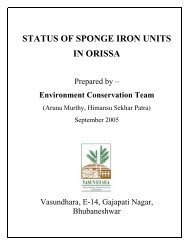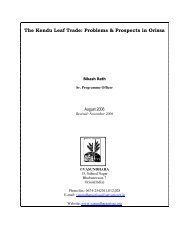Bamboo in Orissa: Trade and Livelihood Perspective - Vasundhara
Bamboo in Orissa: Trade and Livelihood Perspective - Vasundhara
Bamboo in Orissa: Trade and Livelihood Perspective - Vasundhara
Create successful ePaper yourself
Turn your PDF publications into a flip-book with our unique Google optimized e-Paper software.
All rights reserved by VASUNDHARA(www.vasundharaorissa.org). For any clarification, contact author at sunlit1968@yahoo.co.<strong>in</strong><br />
Prahlad Nayak, an experienced employee of OFDC who once worked for Titagarh Paper<br />
Mills, believes that the actual number of cutters <strong>in</strong> the state was with<strong>in</strong> 25000 to 30000(per<br />
comm..), 10 to 15% of which would that of the casual cutters who do not regularly depend<br />
on bamboo cutt<strong>in</strong>g. Interest<strong>in</strong>gly enough, the Empowered Committee on bamboo also said<br />
that revival of bamboo cutt<strong>in</strong>g operations would benefit around 20000 cutters <strong>in</strong> the<br />
state(vide proceed<strong>in</strong>gs of the meet<strong>in</strong>g held on 11-10-04).<br />
To ignore 20 to 25% exaggerations <strong>in</strong> the estimated numbers, the above table suggests that<br />
the maximum concentration of the cutters lies <strong>in</strong> the southern districts. Next comes<br />
Kalah<strong>and</strong>i district of western <strong>Orissa</strong> followed by the coastal districts beyond Ganjam.<br />
In 2005, about 300 cutters were employed by BILT <strong>in</strong> the Dasapalla area for harvest<strong>in</strong>g<br />
around 4000 tons of IB <strong>and</strong> 11000 pieces of long bamboo with<strong>in</strong> a period of less than 6<br />
months(source:Mr.S.D.S<strong>in</strong>ha).<br />
In 1978, cutters were paid Re.0.30 per bundles of salia(per comm., D<strong>and</strong>apani Mohanty)<br />
which <strong>in</strong>creased by more than 10 times by 2000. M<strong>in</strong>imum daily wage was a determ<strong>in</strong><strong>in</strong>g<br />
factor <strong>in</strong> the fixation of cutters' wage although <strong>in</strong> actual cases there was no guarantee that<br />
supervisors work<strong>in</strong>g for private lessees would stick to that.<br />
In 1989-90, the expenditure on cutt<strong>in</strong>g, bundl<strong>in</strong>g <strong>and</strong> stack<strong>in</strong>g was Rs.105/SU of <strong>in</strong>dustrial<br />
bamboo. The production of IB that year be<strong>in</strong>g 231949.53 SU, the total expenditure on this<br />
head was Rs. 24354700.65. At that time, the average m<strong>in</strong>imum daily wage be<strong>in</strong>g Rs.10.50,<br />
this much expenditure would mean 23.19 lakh m<strong>and</strong>ays. Follow<strong>in</strong>g chart <strong>in</strong>dicates the<br />
trend of employment generated from bamboo cutt<strong>in</strong>g as aga<strong>in</strong>st that of the change of<br />
m<strong>in</strong>imum daily wages <strong>and</strong> production of IB over the years 30 :<br />
30 M<strong>and</strong>ays calculation varies for the same year on the basis of the factors used. For <strong>in</strong>stance, <strong>in</strong> 1989-90 total<br />
work<strong>in</strong>g cost was Rs.325, <strong>and</strong> accord<strong>in</strong>gly m<strong>and</strong>ays generated would be about 71 lakhs. Rs.105/SU implied<br />
m<strong>and</strong>ays generated basically <strong>in</strong> the first stage of harvest<strong>in</strong>g i.e., cutt<strong>in</strong>g, dragg<strong>in</strong>g <strong>and</strong> stack<strong>in</strong>g by the cutters.<br />
Other cost of production <strong>in</strong>volves rebundl<strong>in</strong>g at depots, load<strong>in</strong>g <strong>in</strong> trucks, etc., which generate additional<br />
m<strong>and</strong>ays.<br />
53



